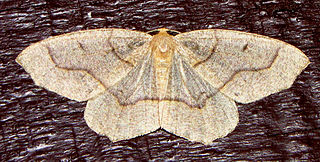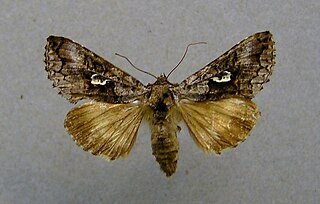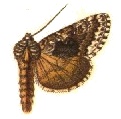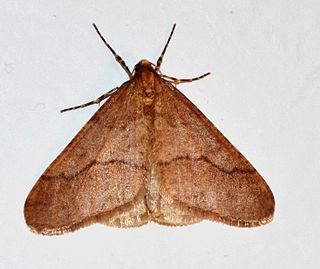
Lymantria dispar, known as the gypsy moth, or the spongy moth, is a species of moth in the Erebidae family. Lymantria dispar is subdivided into several subspecies, with subspecies such as L. d. dispar and L. d. japonica being clearly identifiable without ambiguity. Lymantria dispar has been introduced to several continents and is now found in Europe, Africa, Asia, North America and South America. The polyphagous larvae live on a variety of deciduous and coniferous trees and can cause severe damage in years of mass reproduction. Due to these features, Lymantria dispar is listed among the world's 100 worst invasive alien species.

The geometer moths are moths belonging to the family Geometridae of the insect order Lepidoptera, the moths and butterflies. Their scientific name derives from the Ancient Greek geo γεω, and metron μέτρον "measure" in reference to the way their larvae, or inchworms, appear to measure the earth as they move along in a looping fashion. A very large family, it has around 23,000 species of moths described, and over 1400 species from six subfamilies indigenous to North America alone. A well-known member is the peppered moth, Biston betularia, which has been subject of numerous studies in population genetics. Several other geometer moths are notorious pests.

Freyer's pug is a moth of the family Geometridae. The species can be found in Europe, east to the Urals, the Russian Far East, Kazakhstan and China. It is also found in North America.

Macaria signaria, the dusky peacock, pale-marked angle or spruce-fir looper, is a moth of the family Geometridae. The species was first described by Jacob Hübner in 1809. Subspecies Semiothisa signaria signaria is found in Europe, Turkey, the Caucasus, Transcaucasia, the Ural, Siberia, Far East, Sakhalin, northern Iran and Japan. Subspecies Macaria signaria dispuncta is found in North America.

Syngrapha rectangula, the salt and pepper looper or angulated cutworm, is a moth of the family Noctuidae. The species was first described by William Kirby in 1837. It is found in North America from Newfoundland, Quebec, northern Ontario to Manitoba, New Jersey, northern Pennsylvania, southern Michigan, northern Wisconsin, North Carolina, Virginia, British Columbia, Alberta, Montana, northern Idaho and the Cascades.

Lambdina fiscellaria, the mournful thorn or hemlock looper, is a moth of the family Geometridae. It is found in North America, from the Pacific to the Atlantic coast and from Canada south to Pennsylvania, Wisconsin and California.

Lambdina vitraria is a moth of the family Geometridae. It is found in North America, including Arizona and Utah.

Lambdina pellucidaria, known by the common names pitch pine looper, eastern pine looper and yellow-headed looper, is a moth of the family Geometridae. It is found in eastern parts of the United States, from New York west to Illinois and south to Georgia.

Syngrapha interrogationis, the scarce silver Y, is a moth of the family Noctuidae. It is found in northern part of the world including Alaska, Canada, Iceland, Europe, Siberia, the Pacific Northwest region of the United States, and Northeast Asia.

Lambdina is a genus of moths in the family Geometridae first described by Hahn William Capps in 1943.

Anomis flava, the cotton looper, tropical anomis or white-pupiled scallop moth, is a moth of the family Erebidae. The species was first described by Johan Christian Fabricius in 1775. It is found in large parts of the world, including China, Hawaii, São Tomé and Príncipe, the Society Islands, Thailand, New Zealand, and Australia. Subspecies Anomis flava fimbriago is found in North America.

Syngrapha u-aureum, the golden looper moth, is a moth of the family Noctuidae. It is found from eastern Manitoba to Quebec, Labrador, southern Greenland, Newfoundland, northern Maine, northern New Hampshire and northern New York.

Erannis tiliaria, the linden looper, also known under the rather ambiguous name "winter moth", is a moth of the family Geometridae. The species was first described by Thaddeus William Harris in 1841. It is found in North America from central Alberta east to Nova Scotia, south to Missouri, Georgia, Utah and Texas.
Lambdina laeta is a species of geometrid moth in the family Geometridae. It is found in North America.
Lambdina pultaria, the southern oak looper, is a species of geometrid moth in the family Geometridae. It is found in North America.
Lambdina flavilinearia is a species of moth in the family Geometridae first described by William Barnes and James Halliday McDunnough in 1913. It is found in North America.
The Chécatica River is a salmon river in the Côte-Nord region of Quebec, Canada. It empties into the Gulf of Saint Lawrence.













